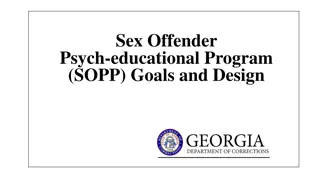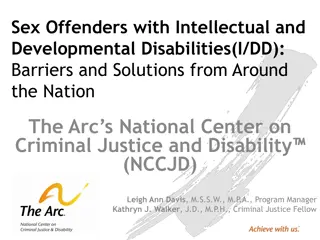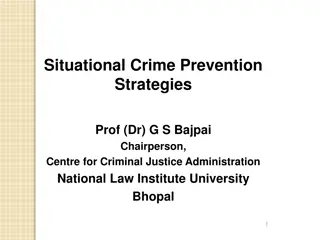Developing Augmented Reality in Youth Offender Learning
The perspective of Romanian youth offenders on developing augmented reality in their learning process.
1 views • 16 slides
Recent Developments in Commonwealth Offenders Sentencing and Mandatory Minimums
Explore recent sentencing developments for Commonwealth offenders in Australia including mandatory minimum sentences in specific offenses. Learn how to navigate Commonwealth sentencing laws, utilize helpful resources, and understand exceptions to mandatory terms of imprisonment for certain specified
0 views • 34 slides
Supporting Children and Young People with Learning Disability and Autism in Liaison and Diversion Services
Marie Hunt, Programme Manager, discusses the importance of supporting children and young people with learning disabilities and/or autism in contact with Liaison and Diversion services and Young Offenders Institutions. The research explores key findings, national data, recommendations, and the role o
0 views • 21 slides
Common Offences Against Animals in India: Overview and Consequences
There are three common offences against animals in India: mischief, cruelty, and bestiality. Mischief involves killing, poisoning, or harming animals, punishable under IPC Sections 428 and 429. Cruelty includes acts like beating, overloading, and starvation, regulated by the Prevention of Cruelty to
0 views • 21 slides
The New Jim Crow: Mass Incarceration and Its Effects
The book "The New Jim Crow" by Michelle Alexander exposes the issues of mass incarceration in the era of colorblindness. It highlights the racial disparities in the criminal justice system, tracing the origins of this racial caste system from slavery to the modern-day prison-industrial complex. The
0 views • 13 slides
Addressing Recidivism through Project R.E.A.P. in Tennessee
Statistics in Tennessee show a high rate of recidivism among offenders, highlighting the need for effective re-entry programs. Project R.E.A.P. focuses on providing education, training, and post-release support to reduce the likelihood of re-arrest and incarceration. The program offers resources lik
0 views • 9 slides
Child Justice Bill 2021 Public Consultation Overview
The Child Justice Bill 2021 Public Consultation provides an opportunity for community engagement to ensure consistency and appropriateness in dealing with child offenders. It aims to establish a clear system for child justice, aligning with international obligations such as the United Nations Conven
0 views • 42 slides
Money Laundering Offences and Investigations in Bangladesh
Bangladesh's Financial Intelligence Unit can authorize investigation agencies to investigate predicate offences, but who will investigate money laundering offences? The Money Laundering Prevention Act, 2012 outlines penalties and forfeiture of property for such offenses. Entities such as banks, fina
0 views • 12 slides
Understanding Borstal: A Former British Youth Correctional System
Borstal was a type of youth detention center in the UK and Commonwealth focusing on re-educating young offenders aged 16-21. The centers aimed to reform delinquents by providing training, skills, and rehabilitation, with the goal of preventing further criminal behavior. Borstal aimed to keep juvenil
0 views • 4 slides
Understanding the Sex Offender Psych-educational Program (SOPP) Goals and Design
The Sex Offender Psych-educational Program (SOPP) focuses on providing psycho-educational sessions for offenders, emphasizing accountability, harm recognition, and behavior control. The program aims to address the abuse of power inherent in sexual offenses and facilitate discussions on responsible c
1 views • 4 slides
The Khyber Pakhtunkhwa Probation and Parole Act, 2021 Overview
The Khyber Pakhtunkhwa Probation and Parole Act, 2021, outlines the establishment and functioning of the criminal justice system in the province. It discusses the roles of various agencies like judiciary, prosecution, police, probation, and prisons in controlling crime. The Directorate of Reclamatio
0 views • 29 slides
Probation of Offenders Ordinance 1960: Salient Features
The Probation of Offenders Ordinance of 1960 in Pakistan allows courts to grant probation to eligible offenders, considering factors like age, character, and nature of the offence. Offenders under probation must adhere to specific conditions and can be supervised by a Probation Officer. Failure to c
0 views • 8 slides
The District Court Reentry Project (DCREP) in Baltimore City
The District Court Reentry Project (DCREP) was initiated by Judge Nicole Pastore Klein in response to the lack of employment opportunities for individuals with criminal records in Baltimore City. The project aims to assist ex-offenders in finding educational and job placement opportunities by collab
0 views • 21 slides
Custody Training Checkpoint at Surrey Police
This training program at Surrey Police focuses on the importance of data quality, specifically emphasizing accuracy, relevance, and timeliness of data entry. It covers the process of Checkpoint within Custody, eligibility criteria, and the introduction of Checkpoint Plus. Surrey Checkpoint aims to r
0 views • 24 slides
Understanding Social Defence in Society
Social defence encompasses the protection, care, and support of marginalized groups through strategic efforts by both the Government and Civil Society. It aims at neutralizing offenders through removal, segregation, or remedial methods, focusing on crime prevention and societal well-being rather tha
0 views • 14 slides
Importance of Medicaid in Jails: Enhancing Healthcare Access
State Health Partners focuses on improving healthcare access for individuals with limited resources or complex needs, especially within the context of Medicaid and jails. Medicaid plays a crucial role in supporting jails to provide healthcare services, impacting cost savings, improved health outcome
0 views • 14 slides
Understanding Child Sexual Exploitation (CSE) in School Communities
Child Sexual Exploitation (CSE) is a form of child sexual abuse involving coercion, manipulation, or deceit for sexual activity. Vulnerable groups include children with disabilities, care leavers, those experiencing bullying, and more. Offenders employ grooming tactics to prepare victims and maintai
0 views • 13 slides
Understanding Remand and Detention in Legal Contexts
Remand refers to the act of placing a defendant on bail or in custody, usually during trial proceedings. Detention, on the other hand, involves confinement or imprisonment for a short period, typically for wrongdoing. Remand homes are British institutions for juvenile offenders awaiting trial or tem
0 views • 4 slides
Juvenile Justice Advisory Group: Raise the Age Case Outcomes December 2022
Beginning on Oct. 1, 2018, for 16-year-olds and Oct. 1, 2019, for 17-year-olds, the Raise the Age initiative led to significant changes in case processing and court outcomes for juvenile offenders in New York. Misdemeanors are now handled through Family Court delinquency procedures, and a Youth Part
1 views • 40 slides
Overview of Education in Minnesota Department of Corrections
Explore the education programs offered at the Minnesota Department of Corrections (DOC) facilities, their mission, vision, and values, as well as future opportunities for offenders. The DOC aims to reduce recidivism through secure incarceration and community supervision, contributing to a safer Minn
0 views • 12 slides
Starting a Transitional Living Program for Ex-Offenders: A Guide by Shelter From the Storm
Establishing a transitional living program for ex-offenders involves assembling a committed team, incorporating as a not-for-profit organization, understanding local laws, and finding a suitable facility. This comprehensive guide outlines key steps and considerations for setting up such a program. F
0 views • 12 slides
Long-Term Impacts of Probation Supervision: A New Perspective
Evaluations of community supervision often yield negative findings due to short follow-up periods and flawed data. Stephen Farrall's research challenges this perception by suggesting a more nuanced understanding of probation's long-term effects. By employing self-report data, longer follow-up period
0 views • 45 slides
Effective Implementation of Civil Citation and Prearrest Diversion Programs in Florida
Civil Citation and Similar Prearrest Diversion Programs in Florida provide an alternative to judicial handling for misdemeanor offenses by focusing on preventing further delinquency. Legislative requirements authorize judicial circuits to establish these programs, specifying eligibility criteria, im
0 views • 17 slides
Specialty Courts and Recidivism Rates in the United States
Specialty Courts, such as Drug Courts and Problem-Solving Courts, provide intensive behavioral supervision and treatment for substance abuse and mental health issues. These courts aim to reduce recidivism rates and engage criminal offenders in therapeutic interventions. Nevada is actively running 42
1 views • 14 slides
Evolution of Youth Justice System and Criminalization of Children
This compilation discusses the historical evolution of the youth justice system, focusing on the age of criminal responsibility, key legislative acts, shifts in mental health and educational involvement, and the contemporary challenges faced in addressing youth offenders. Through a series of images
0 views • 34 slides
Addressing Barriers Faced by Sex Offenders with I/DD
Explore barriers and solutions for sex offenders with Intellectual and Developmental Disabilities (I/DD) presented by experts in the field. Gain insights on disability basics, societal responsibilities, and stories from the system. Learn how professionals are working to tackle these complex issues.
0 views • 77 slides
Effective Strategies for Juvenile Recidivism Reduction
Study findings from Palm Beach County highlight significant statistics related to juvenile offenders, such as recidivism rates, mental health issues, and involvement in foster care or gangs. The importance of reentry programs and core principles for reducing recidivism are discussed, emphasizing the
0 views • 22 slides
Understanding ADR and Restorative Justice in Criminal Cases
Alternative Dispute Resolution (ADR) in Criminal Justice (CJ) involves resolving matters between offenders and the state, focusing on public policy goals like punishment and rehabilitation. Restorative Justice (RJ) is a related process where stakeholders collectively address the aftermath of an offe
0 views • 19 slides
Understanding and Addressing Serious and Violent Youth Offenders
Exploring various aspects of serious and violent youth offenders, this content delves into strategies to reduce recidivism, the impact of state responses, and pathways to delinquency. It challenges misconceptions, provides definitions, and emphasizes the importance of tailored treatment for such ind
0 views • 23 slides
Female Offenders in the Criminal Justice System: Trends and Statistics
Women and girls are a growing segment of the offender population, with significant increases in incarceration rates and involvement in the criminal justice system. This evidence-based and gender-sensitive programming sheds light on the prevalence and growth rate of female offenders, highlighting the
0 views • 42 slides
Impact of Management of Offenders Act on Disclosure Awareness Session
On 30 November 2020, new legislation including the Age of Criminal Responsibility (Scotland) Act 2019 and the Management of Offenders (Scotland) Act 2019 came into force, transforming the disclosure system in Scotland. These changes raise the age of criminal responsibility, reduce rehabilitation per
0 views • 10 slides
Enhancing Interventions for Sex Offenders: The Dynamic Risk Guide
Explore the principles of effective interventions, current strategies for addressing sex offender needs, and incorporating dynamic risk factors to provide targeted interventions. Uncover insights from a survey highlighting areas for improvement and learn about the Dynamic Risk Guide tool aiding agen
0 views • 25 slides
Juvenile Justice System in Thailand: Progress and Challenges
Thailand has a long history of establishing separate Juvenile Courts and implementing laws to protect the rights of children in conflict with the law. The country follows a progressive approach with a focus on rehabilitation for juvenile offenders. The age of criminal responsibility is set at 10 yea
0 views • 46 slides
Illinois Sentencing Policy Advisory Council Meeting Insights
Insights from the Illinois Sentencing Policy Advisory Council's September 17, 2021 meeting include discussions on recidivism costs, fiscal impacts, demographic breakdowns of admissions to IDOC, and analysis of repeat gun offenders' criminal history. The presentation covers data on offenders, non-pro
0 views • 15 slides
Supervision Considerations in Receiving States for Compact Offenders
Explore key training objectives, response to pending charges, and revocable behaviors in supervising compact offenders in receiving states. Learn about the importance of identifying and reporting new offenses and court-related information. Understand the issues surrounding permanent revocation and d
0 views • 22 slides
Understanding Situational Crime Prevention Strategies
Situational crime prevention strategies aim to reduce crime by altering environmental conditions, influencing offender decisions, and targeting crime opportunities. Primary prevention focuses on modifying physical and social environments, while secondary prevention aims to identify potential offende
1 views • 31 slides
Understanding Sentencing of Young Offenders
Explore the judicial processes and options available for sentencing young offenders, focusing on rehabilitation and reformation. Learn about the age of criminal responsibility, types of sentences, and considerations under the Criminal Justice and Immigration Act 2008. Discover the effectiveness of r
0 views • 21 slides
Understanding Sexual Abuse of Minors by Catholic Priests
This content delves into the situational and organizational factors affecting sexual abuse of minors by Catholic priests, exploring types of offenders, grooming techniques, excuses, justifications, and desistance from abuse. It presents data from reports by the John Jay College Research Team and the
0 views • 59 slides
Empowering Youth Offender Learning Through Augmented Reality
Augmented Reality (AR) is being utilized in a European Erasmus-funded project to enhance skills and reduce reoffending among young offenders. Led by Shrewsbury Colleges Group, the project aims to provide interactive learning experiences using AR technology, ultimately helping individuals lead law-ab
0 views • 11 slides
Impact of Stereotypes on Perceived Facial Threat in Women Offenders
Facial expressions play a significant role in understanding emotions, but stereotypes can influence how people perceive facial affect. This study examines how reading tabloid articles about crimes committed by dark and light-skinned women offenders affects the perceived facial threat. Using a 2x2 fa
0 views • 9 slides







































